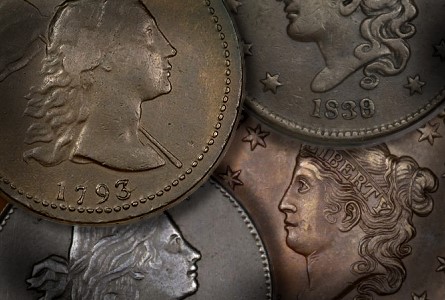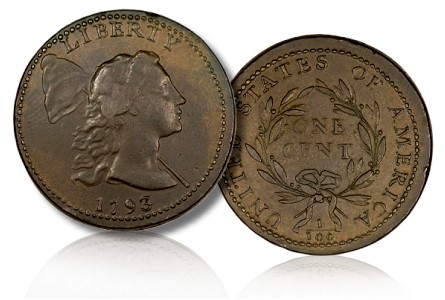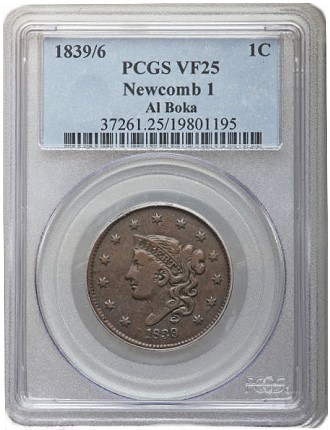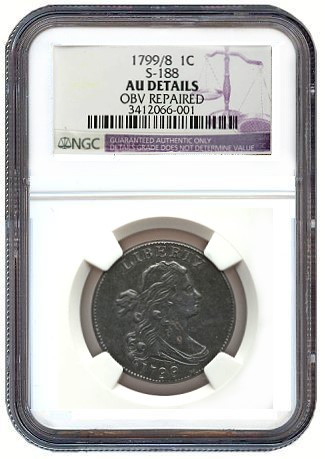News and Analysis of scarce coins, coin markets, and the coin collecting community #71
A Weekly Column by Greg Reynolds
On Thursday, Sept 8th, at 7:00 PM PT, Heritage will auction Al Boka’s collection of large cents ‘by date.’ It is the lead offering of U.S. coins in Heritage’s official auction of the Long Beach Coin, Stamp & Collectible Expo. This convention is held three times per year in Long Beach, California. Heritage will be auctioning a variety of U.S. and world coins.
 Al Boka has been collecting large cents for decades. The current offering is of Boka’s set of all types of large cents, dating from 1793 to 1857, not of Al’s set of varieties of 1794 dated cents. One of the reasons why he is selling his overall collection is to focus upon his set of die varieties of just 1794 dated cents.
Al Boka has been collecting large cents for decades. The current offering is of Boka’s set of all types of large cents, dating from 1793 to 1857, not of Al’s set of varieties of 1794 dated cents. One of the reasons why he is selling his overall collection is to focus upon his set of die varieties of just 1794 dated cents.
I, and many others, define the term ‘date’ to include readily apparent overdates and varieties that are defined by clear, substantial differences in the design elements. So, I note that Al Boka was collecting large cents of all types ‘by date,’ though he is missing a few dates, like the 1799 Normal Date and the 1823 Normal Date. I repeat that he is retaining his 1794s. Boka did not even include a duplicate 1794 in his overall set.
Someone, who incorrectly defines a ‘date’ as just a year, may wish to assert that Boka was collecting “major varieties” of large cents. Regardless of terminology, “The Al Boka Copperheads Collection” contains a number of excellent representatives of keys, better dates and type coins.
“In general, it’s a lovely group,” Denis Loring declares about Al Boka’s set of large cents. A PCGS graded ‘AU-55’ Lettered Edge 1793 Wreath cent “is a beauty, with the Eliasberg pedigree,” Loring adds.
Among the more than seventy-five large cents that Al Boka consigned, he had impressive representatives of five keys: the 1793 Liberty Cap, the 1799/8, the 1804, the 1823/2 and the 1839/6. The three just mentioned overdates are demanded by collectors of large cents ‘by date,’ in addition to being demanded by those who collect large cents ‘by variety.’ While the number of people who collect large cents ‘by variety’ can be counted in the hundreds, more than twenty-five thousand people collect at least one series of large cents ‘by date.’
I. 1793 Liberty Cap Cent
Clearly, the most important large cent in this collection is Boka’s 1793 Liberty Cap Cent. In 2008, I estimated that there survive around three hundred 1793 Liberty Cap Large Cents in all grades, including the ungradable. While there are four die varieties of 1793 Liberty Cap Large Cents, only a small number of people are willing and able to pursue representatives of all four die varieties. It is the thousands of people who collect early large cents ‘by date’ and those who regard this issue as a one-year type who are responsible for the intense demand for 1793 Liberty Cap Large Cents.
 Importantly, the PCGS defines 1793 Liberty Cap Large Cents as one-year type coins. Chain Cents of 1793 and Wreath Cents of this same year are certainly each one-year type coin issues. Liberty Cap Large Cents, however, were produced from 1793 to 1796. There is a noticeable difference between 1793 Liberty Cap cents and those dating from 1794 to 1796.
Importantly, the PCGS defines 1793 Liberty Cap Large Cents as one-year type coins. Chain Cents of 1793 and Wreath Cents of this same year are certainly each one-year type coin issues. Liberty Cap Large Cents, however, were produced from 1793 to 1796. There is a noticeable difference between 1793 Liberty Cap cents and those dating from 1794 to 1796.
The Liberty Cap cents of 1793 have beaded borders, beads near the edge, while those dating from 1794 to 1796 have dentilated borders. Dentils are raised toothlike structures that are found on many U.S. coins. Does the presence of beads rather than dentils really constitute a distinct design type, even though the coins otherwise appear the same? This is not a question to be answered here. A pertinent point is that demand for 1793 Liberty Cap Large Cents became greater after the founding of the PCGS Registry, which requires both a 1793 Liberty Cap Large Cent and a second Liberty Cap, dating from 1794 to 1796, for an overall type set of classic U.S. coins and for various smaller type sets.
The Boka 1793 Liberty Cap is PCGS graded “AU-53” and is graded “Very Fine-35,” by the cataloguer, Mark Borckardt, in accordance with criteria employed by a club of specialists in die varieties of early U.S. copper coins, the EAC. In my view, it just does not make sense to grade this coin less than EF-45. I grade it as AU-50. I believe that most leading grading experts (regarding all classic U.S. coins) would grade it as 50 or higher.
Andy Lustig remarks that it is a “solid AU” and, “despite some unevenness of color on the obverse and a fair number of minor rim nicks, the coin has tons of eye appeal and is easily one of the best 1793 Liberty Caps that I’ve ever seen.” Andy has been attending major coin auctions and conventions for more than twenty-five years.
The Boka 1793 Liberty Cap is one of the finest known, in accordance with grading criteria employed by the PCGS or the NGC. The finest known is the Eliasberg piece, which is PCGS graded MS-64. The Eliasberg 1793 Liberty Cap was recently exhibited at the ANA Convention in Illinois, as part of the High Desert Type Set, which was assembled under the guidance of Scott Travers. The second finest known may be the Garrett coin, which I have never seen.
Some people regard the Naftzger-Husak 1793 as the third finest known, though I do not. It is PCGS graded “AU-55.” I wrote about it in 2008 after it realized $632,500 in the Heritage auction of the Walter Husak collection of early date large cents. In that article, however, I was focusing more on the rarity of 1793 Liberty Cap cents in general, rather than focusing on the characteristics of the Husak 1793, which I now suggest should not have received a 55 grade.
I find the Naftzger-Halpern-Holmes 1793 Liberty Cap to be of higher quality than the Husak piece. Like the Boka coin, it is PCGS graded AU-53. The Naftzger-Halpern-Holmes 1793 Liberty Cap sold for $506,000 in Sept. 2009 when the Goldbergs auctioned Dan Holmes’ collection of early date large cents.
Denis Loring states that the Boka 1793 Liberty Cap is “pretty much defect-free except for a couple of tiny rim nicks.” Indeed, Loring emphasizes that “there are no defects being hidden by the [PCGS holder]. There’s nothing wrong with it at all, and I expect it will bring big bucks.” Loring is one of the most experienced and sophisticated of all large cent collectors. Denis has been studying the details of rare large cents for decades.
The Boka 1793 Liberty Cap is more than attractive. The contact marks in the fields and on the design elements are very minor. The only significant marks are a few very small rim nicks. The fields are naturally smooth and pleasing. The outer design elements are sharply defined and show only slight traces of wear. The darker area in the center of the obverse (front of the coin) indicates that this coin is naturally retoning rather nicely; it is becoming more attractive over time. Although I would have to see more high grade 1793 Liberty Cap Large Cents to form a firm opinion, I would not be surprised to find that the Boka coin is one of the six finest known 1793 Liberty Cap Large Cents overall.
II. 1823/2 Matron Head Cent
 Among Middle Dates, the 1823, the 1823/2 overdate, and the 1839/6 overdate are the only rarities, as dates. (Die varieties are a different topic.) A readily noticeable overdate often (though not always) has the status of a distinct ‘date.’ The 1823/2 cent, by tradition, is collected as a distinct date. So, both an 1823 and an 1823/2 are needed for a complete set of Matron Head Large Cents ‘by date’!
Among Middle Dates, the 1823, the 1823/2 overdate, and the 1839/6 overdate are the only rarities, as dates. (Die varieties are a different topic.) A readily noticeable overdate often (though not always) has the status of a distinct ‘date.’ The 1823/2 cent, by tradition, is collected as a distinct date. So, both an 1823 and an 1823/2 are needed for a complete set of Matron Head Large Cents ‘by date’!
While the 1823 is slightly rarer overall, both issues are tremendous condition rarities in grades of AU-50 or higher. Neither the PCGS nor the NGC has graded an 1823/2 as MS-60 or higher. Both services together have only graded ten to fourteen DIFFERENT 1823/2 cents in the AU-50 to AU-58 range.
Boka’s 1823/2 is PCGS graded “AU-53” and is very likely to be among the ten finest known 1823/2 cents. It is unfortunate that early copper specialists grade this coin from Very Fine-30 to Extremely Fine-40. This coin is very nearly uncirculated. A much stronger case could be made for assigning it an AU-55 grade than for an EF-40 grade. Yes, it is true that this coin has several medium contact marks in the obverse left inner field and on Miss Liberty, especially in the area where her jaw meets her neck. Early copper specialists seem to be deducting significant grade increments due to these few contact marks. Such deductions would not be recognized in the mainstream of the coin collecting community. I am more concerned that some of these contact marks seem to be obscured by dirt or gunk, which is removable. These contact marks, though, are clear in the excellent high resolution images on the Heritage website.
This is one of the best 1823/2 cents that collectors are likely to ever see. It has no serious problems and is very likable. In my view, the PCGS grade is fair and accurate. The 1823/2 issue in general and this coin in particular are under-appreciated, from a logical perspective.
III. 1839/6 Overdate Cents
 The Matron Head type ends in 1835 and another type of Middle Dates was minted from some point in 1835 until 1839. These are distinct from the ‘Late Date,’ Braided Hair design type that started in 1839 and continued until 1857. It is true that the type of 1835 to 1839, which features the ‘Head of 1836’ and the ‘Head of 1838,’ needs a widely accepted name. The key to this type, and one of the rarest of all Middle Date Large Cents, is the 1839/6 overdate.
The Matron Head type ends in 1835 and another type of Middle Dates was minted from some point in 1835 until 1839. These are distinct from the ‘Late Date,’ Braided Hair design type that started in 1839 and continued until 1857. It is true that the type of 1835 to 1839, which features the ‘Head of 1836’ and the ‘Head of 1838,’ needs a widely accepted name. The key to this type, and one of the rarest of all Middle Date Large Cents, is the 1839/6 overdate.
In 2009, I tentatively suggested that there exist around three hundred 1839/6 cents, in all grades. If I am correct, coincidentally, the 1793 Liberty Cap and the 1839/6 cent would be equally rare. I devoted hours to formulating my hypothesis that three hundred 1793 Liberty Cap cents exist. I am not so sure about the number of surviving 1839/6 cents.
In a conversation in March 2009, Chris McCawley found my estimate of three hundred 1839/6 cents to be “fair.” McCawley then pointed out that “two-thirds of them grade Good at best, and maybe ten to twelve could be called Extremely Fine [40] or better.”
Al Boka has three 1839/6 cents, of different die states. Dies progressively wear and sometimes fracture. Boka has 1839/6 cents from three different phases of the same pair of dies. Most collectors of large cents, however, would be happy to own one 1839/6 cent. I suggest that interested collectors acquire just one.
The first of Boka’s 1839/6 cents, an early die state, is PCGS graded ‘Fine-15.’ It seems acceptable. Indeed, it is better than most large cents that are graded Fine-15.
Boka’s second 1839/6, a middle die state, is PCGS graded Very Fine-25 and the Heritage cataloguer, Mark Borckardt, actually agrees with the PCGS grade. It was lightly to moderately dipped very long ago. It has naturally retoned to a significant extent. It is somewhat to mostly original now. There are not many contact marks and this coin does not have any serious problems. It is nice for a VF-25 grade cent.
Boka’s third 1839/6 is also PCGS graded “VF-25,” though it is not as nice. It is of the rarer and readily apparent late die state with horizontal lines from die cracks in the obverse (front) fields. The colors on this coin are awkward. Furthermore, it is not an exciting or pleasing coin, in my view. Collectors who are enthusiastic about seeing the effects of die cracks, however, will like it. This coin does not have any severe problems.
The PCGS has graded just four 1839/6 cents as VF-25, two of which were just mentioned, and only eleven of higher grades, a total which undoubtedly includes some multiple counts of individual coins. The NGC has graded only three above VF-25. Denis Loring remarks that the 1839/6 in general is “tremendously underrated.” I hypothesize that Boka’s second 1839/6 is one of the ten finest known, considering all die states.
IV. 1849 ‘Late Date’ Cent
Late Date Large Cents were minted from 1839 to 1857. In my opinion, the ‘Braided Hair’ name to be appropriate for this type. Among many Late Date Large Cents in the Boka collection, an 1849 in particular caught my attention. It is PCGS certified ‘MS-64 Red & Brown.’ Experts at the PCGS have determined that it has a significant amount of original Mint Red color and I have no doubt that it does. The Boka 1849 is very attractive. Indeed, the original red and toned brown blend on this coin is especially appealing. In my view, it is an excellent coin that is certainly worth a premium.
V. 1799/8 Draped Bust Cent
 The 1799 and the 1799/8 are famous large cent issues. Together, large cents of this year are very scarce. Separately, the 1799/8 is truly rare and neither the PCGS nor the NGC has certified a 1799/8 as grading MS-60 or higher. The PCGS has graded just four in the range from EF-40 to AU-58.
The 1799 and the 1799/8 are famous large cent issues. Together, large cents of this year are very scarce. Separately, the 1799/8 is truly rare and neither the PCGS nor the NGC has certified a 1799/8 as grading MS-60 or higher. The PCGS has graded just four in the range from EF-40 to AU-58.
The NGC has determined that Boka’s 1799/8 overdate is not gradable and that it has the “Details” of an AU-grade coin. The Heritage cataloguer, Mark Borckardt grades it as “VF-30” and points out that other noted large cent specialists have assigned grades ranging from Fine-15 to VF-35.
In many instances, large cent specialists assign numerical grades to coins that the PCGS or the NGC regard as ungradable. In some ways, the grading standards of copper specialists are more conservative and, in other ways, more liberal than the standards of the PCGS or the NGC. It is best to say that their respective criteria are very different.
For coins that the PCGS regards as gradable, in a majority of cases, Borckardt’s grades are lower than the PCGS grades, though, in some cases, Borckardt’s grades are higher. Boka’s 1822 cent is PCGS certified ‘MS-62 Brown’ and is graded “MS-63” by Borckardt. Boka’s 1828 is PCGS graded “AU-58+” and Borckardt graded “MS-60+.”
It is relevant to the Boka 1799/8 that, even in this Boka collection, there are other examples of coins that the NGC indicated are not deserving of a numerical grade, yet have received numerical grades in the Very Fine range from more than one member of the famous club of early copper specialists, the EAC. They do not consider artificial coloring, additives, smoothing, and even repairs to be as serious as do experts at the PCGS, for example, who refer to such coins just as “Genuine” and “Not Gradable.” The NGC assigns a non-numerical ‘Details’ grade, related to the level of sharpness, to a coin that is not gradable. Early copper specialists seem to view all large cents as being gradable.
In my view, experts at the NGC made the right decision by determining that this 1799/8 is not gradable. There is the serious problem regarding the neck and this coin has other issues. Nonetheless, its overall ‘look’ is not bad. At a glance, it fits into a set of gradable early date large cents. It certainly ‘looks’ much better, to the naked eye, than several of the other 1799/8 cents that are also not gradable. It is important to consider the rarity and historical importance of the 1799/8 issue, along with this coin’s impressive level of sharpness and its tolerable color. The Boka 1799/8 is a desirable coin that thousands of collectors would like very much like to have.
VI. 1804 Draped Bust Cent
The 1804 cent issue is scarce and very famous. It is a condition rarity in grades above Very Fine. Al Boka’s 1804 cent is almost certainly one of the twenty-five finest known.
Boka’s 1804 is an especially appealing coin. It is PCGS graded Extremely Fine-40 and it is so. This coin is characterized by even, honest wear. While there is one moderate scratch from the chin to the border, there are very few contact marks, just a few light gashes. All these imperfections would be consistent with a grade above 40. This coin has too much wear, though, for it to grade above 40. This coin is really pleasing for a 40 grade coin. There is no evidence of a significant cleaning and it has probably never been dipped. I believe that the reddish-brown color is natural. The Boka 1804 is very attractive for an EF-40 grade Draped Bust Large Cent.
I am not devoting much space to discuss the Boka 1807/6, which is a very scarce as well. It is PCGS graded “MS-62” and Borckardt graded “AU-55.” At best, this coin grades 55. I would not recommend it.
There are many desirable cents in Al Boka’s “Copperheads Collection.” I wish it was practical to discuss all of them. Boka’s set is impressive. In most cases, Boka selected coins that had naturally smooth fields. Of course, I do not mean perfectly smooth. I am referring to coins that have much fewer imperfections in the fields than average coins of the same respective dates and grades, including imperfections from contact and imperfections that were caused by U.S. Mint personnel. Indeed, this seemed to be a common denominator for most of the coins in Al Boka’s set of large cents.
In other respects as well, Al Boka selected appealing coins for his set of large cents. It was a pleasure to view Boka’s collection. I imagine that collectors and dealers will enthusiastically bid on many of his coins.
©2011 Greg Reynolds




